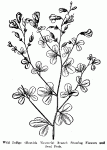 OTHER COMMON NAMES—Baptisia, indigo-weed, yellow indigo, American indigo, yellow broom, indigo-broom, cloverbroom, broom-clover, horsefly-weed, shoofly, rattlebush.
OTHER COMMON NAMES—Baptisia, indigo-weed, yellow indigo, American indigo, yellow broom, indigo-broom, cloverbroom, broom-clover, horsefly-weed, shoofly, rattlebush.
HABITAT AND RANGE—This native herb grows on dry, poor land, and is found from Maine to Minnesota, south to Florida and Louisiana.
DESCRIPTION OF PLANT—Many who have been brought up in the country will recognize in the wild indigo the plant so frequently used by farmers, especially in Virginia and Maryland, to keep flies away from horses, bunches of it being fastened to the harness for this purpose.
Wild Indigo grows about 2 to 3 feet in height and the cloverlike blossoms and leaves will show at once that it belongs to the same family as the common clover, namely, the pea family (Fabaceae.) It is an erect, much-branched, very leafy plant of compact growth, the 3-leaved, bluish green foliage somewhat resembling clover leaves. The flowers, as already stated, are like common clover flowers-that is, not like clover heads, but the single flowers composing these; they are bright yellow, about one-half inch in length and are produced in numerous clusters which appear from June to September. The seed pods, on stalks longer than the calyx, are nearly globular or ovoid and are tipped with an awl shaped style.
Another species, said to possess properties similar to those of Baptisia tinctoria and substituted for it, is B. alba R. Br., called the white wild indigo. This plant has white flowers and is found in the Southern States and on the plains of the Western States.
DESCRIPTION OF ROOT—Wild Indigo has a thick, knotty crown or head, with several stem scars, and a round, fleshy root, sending out cylindrical branches and rootlets almost 2 feet in length. The white woody interior is covered with a thick, dark brown bark, rather scaly or dotted with small, wartlike excrescences. The root breaks with a tough, fibrous fracture. There is a scarcely perceptible odor and the taste, which resides chiefly in the bark, is nauseous, bitter and acrid.
COLLECTION, PRICES AND USES—The root of Wild Indigo is collected in autumn, and brings from 4 to 8 cents a pound.
Large doses of Wild Indigo are emetic and cathartic and may prove dangerous. It also has stimulant, astringent and antiseptic properties, and is used as a local application to sores, ulcers, etc.
The herb is sometimes employed like the root and the entire plant was official from 1830 to 1840.
In some sections the young, tender shoots are used for greens, like those of pokeweed, but great care must be exercised to gather them before they are too far advanced in growth, as otherwise bad results will follow.
A blue coloring matter has been prepared from the plant and used as a substitute for indigo, to which, however, it is very much inferior.
Ginseng and Other Medicinal Plants, 1936, was written by A. R. Harding.

